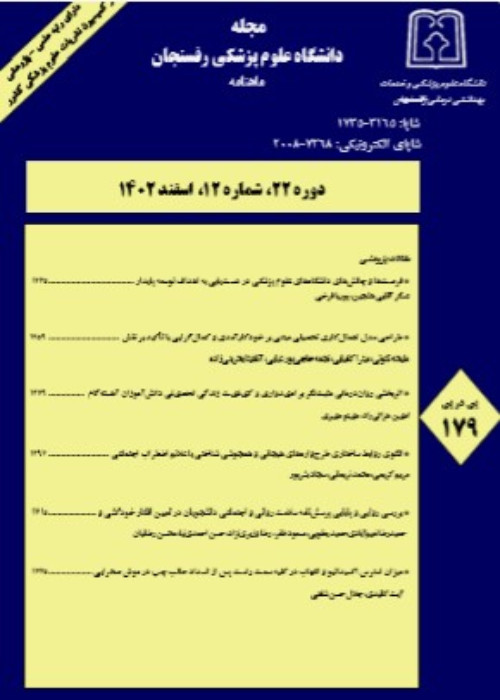The Effects of Stabilizing Exercises in the Patients with Lumbar Disc Hernia
Author(s):
Abstract:
Background
One of the most important roles of the lumbar intervertebral disc is to provide the stability between adjacent vertebras. This function will be confused during the lumbar disc herniation. stabilizer exercises (SE) have been recommended for patients with low back injury to improve the lumbar function, so these patients may perform their activities of daily living (ADL) more easily. This study has been designed to investigate the effects of the SE in the patients with lumbar disc hernia. Materials And Methods
Sixty patients (22-55 years old) with lumbar disc hernia at L4-L5 or L5-S1 (without any motor or sensory deficiency) were randomly divided into two groups of thirty (experimental and control). The SE protocol includes 4 stages, from easy to advanced, and each stage was taught to the experimental group in the first session of each week. The exercises had to be performed ten times at home twice a day. Parameters were measured at the first session and repeated each week. The pain was measured by visual analogue scale, trunk flexion in the long sitting position (without pain), straight leg raising (SLR) angle without pain and time to complete the following ADL tasks climbing 5 steps, 10 meter fast walking without pain, lying prone from the standing position and standing from the prone position. The measurements were repeated after a four week follow up. Results
Significant pain relief (p<0.0001), left and right SLR angle improvement (p<0.005) and increased trunk flexion (p<0.0001) were found in the experimental group, but not in the control group. The time required to fulfill the ADL tasks were also reduced significantly (p<0.05). These results were stable after the follow up period. Conclusion
The results showed that the SE protocol may improve the ADL performance in the patients with lumbar disc hernia, which may indicate the effectiveness of the SE to provide enough stability in the lumbar region of these patients.Language:
Persian
Published:
Journal of Rafsanjan University Of Medical Sciences, Volume:3 Issue: 3, 2004
Page:
156
magiran.com/p253907
دانلود و مطالعه متن این مقاله با یکی از روشهای زیر امکان پذیر است:
اشتراک شخصی
با عضویت و پرداخت آنلاین حق اشتراک یکساله به مبلغ 1,390,000ريال میتوانید 70 عنوان مطلب دانلود کنید!
اشتراک سازمانی
به کتابخانه دانشگاه یا محل کار خود پیشنهاد کنید تا اشتراک سازمانی این پایگاه را برای دسترسی نامحدود همه کاربران به متن مطالب تهیه نمایند!
توجه!
- حق عضویت دریافتی صرف حمایت از نشریات عضو و نگهداری، تکمیل و توسعه مگیران میشود.
- پرداخت حق اشتراک و دانلود مقالات اجازه بازنشر آن در سایر رسانههای چاپی و دیجیتال را به کاربر نمیدهد.
دسترسی سراسری کاربران دانشگاه پیام نور!
اعضای هیئت علمی و دانشجویان دانشگاه پیام نور در سراسر کشور، در صورت ثبت نام با ایمیل دانشگاهی، تا پایان فروردین ماه 1403 به مقالات سایت دسترسی خواهند داشت!
In order to view content subscription is required
Personal subscription
Subscribe magiran.com for 70 € euros via PayPal and download 70 articles during a year.
Organization subscription
Please contact us to subscribe your university or library for unlimited access!


